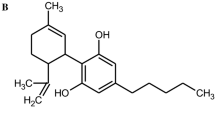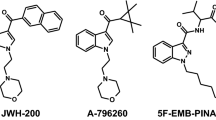Abstract
Products containing synthetic cannabinoids are consumed as a surrogate for marihuana due to their non-detectability with commonly used drug tests and their strong cannabimimetic effects. Because data concerning their toxicological properties are scarce, the cytotoxic, genotoxic, immunomodulatory, and hormonal activities of four naphthoylindole compounds (JWH-018, JWH-073, JWH-122 and JWH-210) and of one benzoylindole (AM-694) were studied in human cell lines and primary cells; tetrahydrocannabinol was included as the classical non-endogenous cannabinoid receptor ligand. All compounds induced damage to the cell membranes of buccal (TR146) and breast (MCF-7) derived cells at concentrations of ≥75–100 μM. No cytotoxic responses were seen in other assays which reflect mitochondrial damage, protein synthesis, and lysosomal activities. JWH-073 and JWH-122 induced DNA migration in buccal and liver cells (HepG2) in single cell gel electrophoresis assays, while JWH-210 was only in the latter cell line active. No estrogenic activities were detected in bone marrow cells (U2-OS), but all compounds caused anti-estrogenic effects at levels between 2.1 and 23.0 μM. Furthermore, no impact on cytokine release (i.e., on IL-10, IL-6, IL-12/23p40 and TNFα levels) was seen in LPS-stimulated human PBMCs, except with JWH-210 and JWH-122 which caused a decrease of TNFα and IL-12/23p40. All toxic effects were observed with concentrations higher than those expected in body fluids of users. Since genotoxic effects are in general linear over a wide concentration range and the exposure levels may be higher in epithelial cells or in serum, further experimental work is required to find out if DNA damage takes place in drug users.





Similar content being viewed by others
Abbreviations
- LDHe:
-
Extracellular lactate dehydrogenase
- IL:
-
Interleukin
- NR:
-
Neutral red
- SRB:
-
Sulforhodamine B
- SCGE:
-
Single cell gel electrophoresis
- TNFα:
-
Tumor necrosis factor α
- XTT:
-
2,3-Bis(2-methoxy-4-nitro-5-sulfophenyl)-5-[(phenyl-amino)carbonyl]-2H-tetrazolium hydroxide
References
Bartek J (2011) DNA damage response, genetic instability and cancer: from mechanistic insights to personalized treatment. Mol Oncol 5(4):303–307
Berryman SH, Anderson RA Jr, Weis J, Bartke A (1992) Evaluation of the co-mutagenicity of ethanol and delta 9-tetrahydrocannabinol with Trenimon. Mutat Res 278(1):47–60
Brooks SC, Locke ER, Soule HD (1973) Estrogen receptor in a human cell line (MCF-7) from breast carcinoma. J Biol Chem 248(17):6251–6253
Brosin A, Wolf V, Mattheus A, Heise H (1997) Use of XTT-assay to assess the cytotoxicity of different surfactants and metal salts in human keratinocytes (HaCaT). A feasible method for in vitro testing of skin irritants. Acta Derm Venereol 77(1):26–28
Fattore L, Fratta W (2011) Beyond THC: the new generation of cannabinoid designer drugs. Front Behav Neurosci 5:60
Fischer-Stenger K, Dove Pettit DA, Cabral GA (1993) Delta 9-tetrahydrocannabinol inhibition of tumor necrosis factor-alpha: suppression of post-translational events. J Pharmacol Exp Ther 267(3):1558–1565
Florea AM, Busselberg D (2008) Arsenic trioxide in environmentally and clinically relevant concentrations interacts with calcium homeostasis and induces cell type specific cell death in tumor and non-tumor cells. Toxicol Lett 179(1):34–42
Fotakis G, Timbrell JA (2006) In vitro cytotoxicity assays: comparison of LDH, neutral red, MTT and protein assay in hepatoma cell lines following exposure to cadmium chloride. Toxicol Lett 160(2):171–177
Germain N, Boichot E, Advenier C, Berdyshev EV, Lagente V (2002) Effect of the cannabinoid receptor ligand, WIN 55,212–2, on superoxide anion and TNF-alpha production by human mononuclear cells. Int Immunopharmacol 2(4):537–543
Gunderson EW, Haughey HM, Ait-Daoud N, Joshi AS, Hart CL (2012) “Spice” and “k2” herbal highs: a case series and systematic review of the clinical effects and biopsychosocial implications of synthetic cannabinoid use in humans. Am J Addict 21(4):320–326
Hermanns-Clausen M, Kneisel S, Szabo B, Auwarter V (2013) Acute toxicity due to the confirmed consumption of synthetic cannabinoids: clinical and laboratory findings. Addiction 108(3):534–544. doi:10.1111/j.1360-0443.2012.04078.x
Kisselev P, Schwarz D, Platt KL, Schunck WH, Roots I (2002) Epoxidation of benzo[a]pyrene-7,8-dihydrodiol by human CYP1A1 in reconstituted membranes. Effects of charge and nonbilayer phase propensity of the membrane. Eur J Biochem 269(7):1799–1805
Klegeris A, Bissonnette CJ, McGeer PL (2003) Reduction of human monocytic cell neurotoxicity and cytokine secretion by ligands of the cannabinoid-type CB2 receptor. Br J Pharmacol 139(4):775–786
Klein TW (2005) Cannabinoid-based drugs as anti-inflammatory therapeutics. Nat Rev Immunol 5(5):400–411
Klein TW, Newton C, Widen R, Friedman H (1993) Delta 9-tetrahydrocannabinol injection induces cytokine-mediated mortality of mice infected with Legionella pneumophila. J Pharmacol Exp Ther 267(2):635–640
Klein TW, Newton C, Larsen K, Lu L, Perkins I, Nong L, Friedman H (2003) The cannabinoid system and immune modulation. J Leukoc Biol 74(4):486–496
Knasmuller S, Parzefall W, Sanyal R, Ecker S, Schwab C, Uhl M, Mersch-Sundermann V, Williamson G, Hietsch G, Langer T, Darroudi F, Natarajan AT (1998) Use of metabolically competent human hepatoma cells for the detection of mutagens and antimutagens. Mutat Res 402(1–2):185–202
Knasmuller S, Mersch-Sundermann V, Kevekordes S, Darroudi F, Huber WW, Hoelzl C, Bichler J, Majer BJ (2004) Use of human-derived liver cell lines for the detection of environmental and dietary genotoxicants; current state of knowledge. Toxicology 198(1–3):315–328
Kneisel S, Auwarter V (2012) Analysis of 30 synthetic cannabinoids in serum by liquid chromatography-electrospray ionization tandem mass spectrometry after liquid–liquid extraction. J Mass Spectrom 47(7):825–835
Koskinen M, Plna K (2000) Specific DNA adducts induced by some mono-substituted epoxides in vitro and in vivo. Chem Biol Interact 129(3):209–229
Lindl T, Bauer J (1989) Zell- und Gewebekultur. Stuttgart
Lutz WK (2000) A true threshold dose in chemical carcinogenesis cannot be defined for a population, irrespective of the mode of action. Hum Exp Toxicol 19(10):566–568 (discussion 571–562)
Maines MD (1998) In vitro methods for detecting cytotoxicity in current protocols in toxicology. Wiley, Hoboken
Majer BJ (2003) New hope for laboratory animals: in vitro genotoxicity tests with human hepatoma cell lines detect human food carcinogens. Formal- und Naturwissenschaftliche Fakultät
Mir A, Obafemi A, Young A, Kane C (2011) Myocardial infarction associated with use of the synthetic cannabinoid K2. Pediatrics 128(6):e1622–e1627
Monnet-Tschudi F, Hazekamp A, Perret N, Zurich MG, Mangin P, Giroud C, Honegger P (2008) Delta-9-tetrahydrocannabinol accumulation, metabolism and cell-type-specific adverse effects in aggregating brain cell cultures. Toxicol Appl Pharmacol 228(1):8–16
Morishima A (1984) Effects of cannabis and natural cannabinoids on chromosomes and ova. NIDA Res Monogr 44:25–45
Muller M, Strand S, Hug H, Heinemann EM, Walczak H, Hofmann WJ, Stremmel W, Krammer PH, Galle PR (1997) Drug-induced apoptosis in hepatoma cells is mediated by the CD95 (APO-1/Fas) receptor/ligand system and involves activation of wild-type p53. J Clin Invest 99(3):403–413
Nandhakumar S, Parasuraman S, Shanmugam MM, Rao KR, Chand P, Bhat BV (2011) Evaluation of DNA damage using single-cell gel electrophoresis (Comet Assay). J Pharmacol Pharmacother 2(2):107–111
Okey AB, Truant GS (1975) Cannabis demasculinizes rats but is not estrogenic. Life Sci 17(7):1113–1117
Rawitch AB, Schultz GS, Ebner KE, Vardaris RM (1977) Competition of delta 9-tetrahydrocannabinol with estrogen in rat uterine estrogen receptor binding. Science 197(4309):1189–1191
Repetto G, del Peso A, Zurita JL (2008) Neutral red uptake assay for the estimation of cell viability/cytotoxicity. Nat Protoc 3(7):1125–1131
Rupniak HT, Rowlatt C, Lane EB, Steele JG, Trejdosiewicz LK, Laskiewicz B, Povey S, Hill BT (1985) Characteristics of four new human cell lines derived from squamous cell carcinomas of the head and neck. J Natl Cancer Inst 75(4):621–635
Saemann MD, Bohmig GA, Osterreicher CH, Burtscher H, Parolini O, Diakos C, Stockl J, Horl WH, Zlabinger GJ (2000) Anti-inflammatory effects of sodium butyrate on human monocytes: potent inhibition of IL-12/23p40 and up-regulation of IL-10 production. Faseb J 14(15):2380–2382
Seely KA, Lapoint J, Moran JH, Fattore L (2012) Spice drugs are more than harmless herbal blends: a review of the pharmacology and toxicology of synthetic cannabinoids. Prog Neuropsychopharmacol Biol Psychiatry 39(2):234–243. doi:10.1016/j.pnpbp.2012.04.017
Skehan P, Storeng R, Scudiero D, Monks A, McMahon J, Vistica D, Warren JT, Bokesch H, Kenney S, Boyd MR (1990) New colorimetric cytotoxicity assay for anticancer-drug screening. J Natl Cancer Inst 82(13):1107–1112
Takeda S, Yamaori S, Motoya E, Matsunaga T, Kimura T, Yamamoto I, Watanabe K (2008) Delta(9)-Tetrahydrocannabinol enhances MCF-7 cell proliferation via cannabinoid receptor-independent signaling. Toxicology 245(1–2):141–146
Teske J, Weller JP, Fieguth A, Rothamel T, Schulz Y, Troger HD (2010) Sensitive and rapid quantification of the cannabinoid receptor agonist naphthalen-1-yl-(1-pentylindol-3-yl)methanone (JWH-018) in human serum by liquid chromatography-tandem mass spectrometry. J Chromatogr B Analyt Technol Biomed Life Sci 878(27):2659–2663
Tice RR, Agurell E, Anderson D, Burlinson B, Hartmann A, Kobayashi H, Miyamae Y, Rojas E, Ryu JC, Sasaki YF (2000) Single cell gel/comet assay: guidelines for in vitro and in vivo genetic toxicology testing. Environ Mol Mutagen 35(3):206–221
Tomiyama K, Funada M (2011) Cytotoxicity of synthetic cannabinoids found in “Spice” products: the role of cannabinoid receptors and the caspase cascade in the NG 108–15 cell line. Toxicol Lett 207(1):12–17
UNODC (2011) Synthetic cannabinoids in herbal products. http://www.unodc.org/documents/scientific/Synthetic_Cannabinoids.pdf
van der Burg B, Winter R, Weimer M, Berckmans P, Suzuki G, Gijsbers L, Jonas A, van der Linden S, Witters H, Aarts J, Legler J, Kopp-Schneider A, Bremer S (2010) Optimization and prevalidation of the in vitro ERalpha CALUX method to test estrogenic and antiestrogenic activity of compounds. Reprod Toxicol 30(1):73–80
Vara D, Salazar M, Olea-Herrero N, Guzman M, Velasco G, Diaz-Laviada I (2011) Anti-tumoral action of cannabinoids on hepatocellular carcinoma: role of AMPK-dependent activation of autophagy. Cell Death Differ 18(7):1099–1111
Vichai V, Kirtikara K (2006) Sulforhodamine B colorimetric assay for cytotoxicity screening. Nat Protoc 1(3):1112–1116
Vodicka P, Koskinen M, Arand M, Oesch F, Hemminki K (2002) Spectrum of styrene-induced DNA adducts: the relationship to other biomarkers and prospects in human biomonitoring. Mutat Res 511(3):239–254
von Bueren AO, Schlumpf M, Lichtensteiger W (2008) Delta(9)-tetrahydrocannabinol inhibits 17beta-estradiol-induced proliferation and fails to activate androgen and estrogen receptors in MCF7 human breast cancer cells. Anticancer Res 28(1A):85–89
Wang JS, Groopman JD (1999) DNA damage by mycotoxins. Mutat Res 424(1–2):167–181
Watanabe K, Yamaori S, Funahashi T, Kimura T, Yamamoto I (2007) Cytochrome P450 enzymes involved in the metabolism of tetrahydrocannabinols and cannabinol by human hepatic microsomes. Life Sci 80(15):1415–1419
Winter HK, Ehrlich VA, Grusch M, Lackner A, Schulte-Hermann R, Grasl-Kraupp B, Mikulits W, Knasmuller S (2008) Use of four new human-derived liver-cell lines for the detection of genotoxic compounds in the single-cell gel electrophoresis (SCGE) assay. Mutat Res 657(2):133–139
Zhang Q, Ma P, Cole RB, Wang G (2006) Identification of in vitro metabolites of JWH-015, an aminoalkylindole agonist for the peripheral cannabinoid receptor (CB2) by HPLC-MS/MS. Anal Bioanal Chem 386(5):1345–1355
Zimmermann US, Winkelmann PR, Pilhatsch M, Nees JA, Spanagel R, Schulz K (2009) Withdrawal phenomena and dependence syndrome after the consumption of “spice gold”. Dtsch Arztebl Int 106(27):464–467
Acknowledgments
This study was conducted in the frame of the project “Spice and synthetic cannabinoids” (JUST/2009/DPIP/AG/0948) and was financially supported by the EU Commission, the German Ministry of Health and the City of Frankfurt/Main. Furthermore, the authors are thankful to. P. Behnisch and H. Besselink (BioDetection Systems BV, The Netherlands) for their support in regard to the realization of the estrogen measurements.
Author information
Authors and Affiliations
Corresponding author
Electronic supplementary material
Below is the link to the electronic supplementary material.
Rights and permissions
About this article
Cite this article
Koller, V.J., Zlabinger, G.J., Auwärter, V. et al. Toxicological profiles of selected synthetic cannabinoids showing high binding affinities to the cannabinoid receptor subtype CB1 . Arch Toxicol 87, 1287–1297 (2013). https://doi.org/10.1007/s00204-013-1029-1
Received:
Accepted:
Published:
Issue Date:
DOI: https://doi.org/10.1007/s00204-013-1029-1




